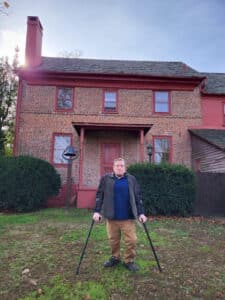Moving in Reverse: Monmouth County Guts Its Complete Streets Policy
by Cyndi Steiner & Aaron Hyndman

In 2010, Monmouth County made a landmark commitment to safer roadways by being the first county in New Jersey to adopt a Complete Streets plan. Sadly, the progress that was put in motion five years ago is in danger of grinding to a halt. Last month, Monmouth County established a set of Bicycle Facility Policy Guidelines that, instead of facilitating the installation of bicycling accommodations, will almost certainly be an impediment to the development of the network of safe bike lanes that the residents of Monmouth County were promised in 2010.
By law, the responsibility to fund the construction and maintenance of county roadways lies with the county government, not the municipalities. However, Monmouth County’s new Bicycling Facility Policy and Guidelines, as stated in Resolution 2015-0352, change that dramatically. According to the new Guidelines, all pavement markings and regulatory signs pertaining to bike lanes on county roadways are to be installed at the municipality’s expense. In addition, the Policy Guidelines also force municipalities to assume the costs of planning and design for bicycling facilities on county roads. These cities, boroughs and townships, already responsible for financing their own roads and streets, are now being unfairly forced to bear the burden of funding installations on county roadways that are not, and should not be, their responsibility. Not only is such a policy unfair, it’s also unwieldy, as it unnecessarily compartmentalizes and complicates what should be a streamlined and centralized planning process under the guidance of the County Engineer.
Fair Haven Mayor Ben Lucarelli describes this action as putting a knife right through the 2010 Complete Streets Policy. Monmouth County’s Freeholders cannot be allowed to renege on their commitment to Complete Streets in such a manner that unfairly passes the buck, imposing financial and logistical obligations on municipalities that are already doing their fair share with regards to their own roads and streets. To do so threatens future installation of the bicycling facilities Monmouth County residents have been promised.
Monmouth County’s 2010 Resolution states that where “practicable,” the Monmouth County Complete Streets Program “shall include all road, bridge, and building projects funded through Monmouth County’s Capital Program.” The facts show that such inclusion is entirely feasible, despite County officials stating that the $15,000 per mile cost of bicycling facilities is an expense that exceeds the county’s financial limitations. Not only is $15,000 a mere fraction of the total per mile cost of repaving a roadway, but federal and state funding for bicycling facilities is also available to counties, thereby mitigating the cost of such installations.
What’s lacking is not the capital required to fund complete streets in Monmouth County. All that is absent is the political will for Monmouth County officials to follow through with the promises they’ve made regarding safe streets for all residents who use them. It’s time to hold the Monmouth County Board of Freeholders accountable, and ensure that they make good on their obligation to provide for their residents the safety of complete streets.
Cyndi Steiner is the Executive Director of the New Jersey Bike & Walk Coalition. Aaron Hyndman serves as the organization’s Communications Coordinator.
[ed. note – A previous edition of this article indicated that the Bicycle Facility Policy Guidelines, passed on April 23, were voted on not during the open meeting, but in executive session. NJBWC has verified that this was not the case, and has amended this post accordingly.]














































































